Conifer Essential Oils Guide
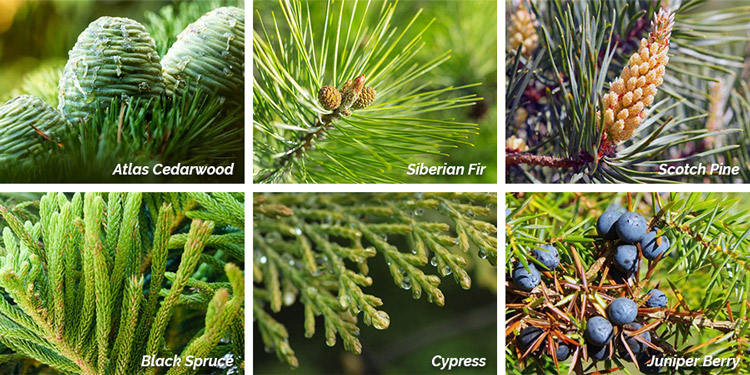
Conifer Guide Sections:
- Introduction
- What is a Conifer?
- Is a Conifer the Same Thing as an Evergreen?
- Conifer Plant Classification
- How Can You Tell the Difference Between a Fir, Spruce and Pine?
- Forest Bathing: Spending Time in the Forest
- How Can Coniferous Essential Oils Help if I Can't Spend Time in a Forest?
- The Uses and Benefits of Conifer Essential Oils
- General Safety Information for Conifer Essential Oils
- The Shelf Life of Conifer Essential Oils
- Conifers in the Pinaceae Family (Atlas Cedarwood, Pines, Firs, Spruces)
- Conifers in the Cupressaceae Family (Virginian Cedarwood, Cypress, Juniper Berry)
- General Safety Information
Introduction to Coniferous Essential Oils
What a joy it has been to finally prepare and publish this guide to Conifer Essential Oils on AromaWeb. While growing up in Southeastern Michigan, I was able to enjoy spending a lot of time outside in a densely wooded area, savoring the beauty, shade and aroma of the spruce and pine trees. These days, I work very long hours, and I have far less time to explore and forest bathe (see below for more about forest bathing). Mindful diffusion of my conifer essential oils has made such a difference in helping me continue to feel a connection to the forest and these beautiful trees. As primarily invigorating oils, they have been helpful to keep me focused as I prepare this rather detailed guide.
These beautiful oils are so helpful in a range of physical, emotional, spiritual and seasonal applications. This guide provides an introduction to conifers as a part of the plant kingdom. It also provides an overview to many of the more commonly available conifer essential oils, their uses and their benefits. Each of the oil summaries provides a link to AromaWeb's essential oil profile for the corresponding oil so that you can obtain more information about the oil.
What is a Conifer?
According to the online version of the Merriam-Webster Dictionary, a conifer is "any of an order (Coniferales) of mostly evergreen trees and shrubs having usually needle-shaped or scalelike leaves and including forms (such as pines) with true cones and others (such as yews) with an arillate fruit." It originates from the Latin word conus (meaning cone) and fer (meaning bearing).1
The conifers that bear essential oils used within the field of holistic aromatherapy belong primarily to two botanical families, the pinaceae family and the cupressaceae family. I have organized the oil summaries shown below based upon the botanical family that each oil belongs to.
Is a Conifer the Same Thing as an Evergreen?
An evergreen is a plant or shrub that continuously maintains green leaves. Deciduous plants, on the other hand, have leaves that change color and fall off. Evergreens are always (ever) green.2
Most conifers are evergreens, but not all evergreens are conifers. Larch Trees, also known as Tamaracks, for example, is a deciduous conifer. (AromaWeb doesn't presently have a profile available for Larch Essential Oil, but intends to in the future.) Most of the eucalypts (eucalyptus) are evergreens, but they are not conifers.
Conifer Plant Classification
Without intending to give you a complicated introduction to botany, the plant kingdom is broken down into subkingdoms and is then further broken down to help organize plants by their similar characteristics:
- Subkingdom: Tracheobionta (Vascular Plants)
- Superdivision: Spermatophyta (Seed Plants)
- Division: Coniferophyta (Conifers)
- Class: Pinopsida
- Order: Pinales
- Family: Pinaceae (Pine) or Cupressaceae (Cypress)
The Coniferophyta (Conifers) Division is divided into one class, the Pinopsida Class. The Pinopsida Class is divided into two orders, the Pinales Order and the Taxales Order. The Taxales Order consists primarily of Yews, an evergreen that is toxic and isn't used within holistic aromatherapy applications. Of the families that belong to the Pinales Order, the Pinaceae (Pine) and Cupressaceae (Cypress) families are focused upon within holistic aromatherapy because they are the two families that primarily yield the essential oil bearing plants used within holistic aromatherapy.3
How Can You Tell the Difference Between a Fir, Spruce and Pine?
Fir, spruce and pine trees are all evergreen trees. They possess physical characteristics that can help distinguish between them. Living in Michigan, we have varieties of fir, spruce and pine. The following guide, written by Educator and Master Gardener Coordinator Mary Wilson and hosted by Michigan State University, can help you learn how to differentiate between these three types of Pinaceae conifers: Pine, spruce or fir: Getting to know Michigan evergreen trees
Forest Bathing: Spending Time in the Forest
Forest Bathing doesn't actually involve bathing or swimming in the forest or anywhere outside. Instead, the idea is to spend time in a forest or wooded area, preferably without distractions. By spending time amongst trees, the idea is to "bathe" (soak) in the beauty, inhaling the beautiful coniferous and earthy odors of the trees, leaves, needles and surrounding plants. Forest bathing allows participants the ability to connect with the trees, establish a relationship with the plants, and develop a greater sense of gratitude and presence in the moment. Forest bathing has the potential to help ease stress and feelings of depression and can help to feel more centered and grounded. For more information, read Sedona Aromatics' post: What is Forest Bathing?5
How Can Coniferous Essential Oils Help if I Can't Spend Time in a Forest?
The reality is that many of us don't live near forests filled with coniferous plants. Some of us have responsibilities or disabilities that keep us from being able to spend more time outdoors. These days, the concerns over some people not respecting social distancing practices, acts of violence and the greater need for protection against UV rays and ticks also reduce the motivation and ability to spend ample time in wooded areas.
Mindfully diffusing coniferous essential oils while visualizing a walk through the forest can serve as a lovely substitute. It's certainly not as ideal as truly getting out amongst the trees, but it can serve as a wonderful experience. Juniper, Cypress, Pine, Spruce and Fir Essential Oils can be quite stimulating, so they should be used sparingly and carefully when seeking to achieve a balanced, grounded state of mind. Virginia Cedarwood Essential Oil, however, is a beautiful oil to incorporate into blends when you are seeing to feel more grounded.
The Uses and Benefits of Conifer Essential Oils
When working with essential oils that are conifers, we have to be careful to not assume that every single oil distilled from a conifer behaves the same way or has the same safety precautions. Very broadly speaking, the needle/leaf oils from spruce, fir, pine and cypress trees are stimulating and invigorating. They can be helpful in applications intended to support congestion and respiratory health. Emotionally, they can be helpful in energizing blends and blends intended to help support focus. They're also helpful in massage blends. Atlas and Virginian Cedarwood oils are not as stimulating. Study the details about each conifer oil to learn the unique properties and attributes for each oil.
General Safety Information for Conifer Essential Oils
Essential Oil Safety Edition 2 by Robert Tisserand and Rodney Young do not indicate any serious concerns when using the conifer essential oils listed in this guide topically or in diffusion with the exception of Blue Cypress. They advise to avoid during pregnancy and lactation as it may interact with drugs and may be fetotoxic. They do advise to avoid using oxidized (aging) conifer oils topically due to the increased risk of sensitization. Reading Tisserand and Young's profile for every oil that you work with is strongly recommended.4
The Shelf Life of Conifer Essential Oils
Most of the coniferous essential oils distilled from the needles and twigs are abundant in monoterpenes. Monoterpenes oxide rather quickly and have a shorter shelf life. Therefore, pine, spruce, cypress and fir oils have a shelf life of just a year or two. However, Atlas and Virginian Cedarwood oils consist of approximately 80% sesquiterpenes and have a shelf life closer to 6-8 years. For more information about determining the shelf life or best use by date for essential oils, read AromaWeb's Guide to Essential Oil Shelf Life.
The Pinaceae Family
Essential Oils Distilled from Conifers in the Pinaceae Family
Therapeutically, fir, spruce and pine essential oils are generally distilled from the needles of the tree and tend to be emotionally stimulating essential oils that can be helpful with respiratory and muscular issues. However, the properties and safety data for each essential oil, regardless of its classification, should be reviewed individually as there can be differences.
Cedarwood, Atlas
Botanical Name: Cedrus atlantica
Plant Part(s) Typically Distilled: Wood
Conservation Status: Endangered*
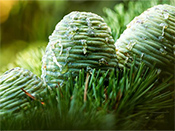
Atlas Cedarwood Essential Oil possesses a sharp, woody aroma. It is much more abundant in sesquiterpenes than the pine, spruce and fir oils and has a longer shelf life. Most of the other conifer essential oils from the Pinaceae family are distilled from the needles and twigs of the tree, and thus doesn't require the entire tree to be cut down. However, Atlas Cedarwood Oil is distilled from the wood of the tree, requiring the trees to be cut down. Atlas Cedarwood is endangered according to the IUCN Redlist. Whenever possible, please source your oil from companies that have responsible conservation efforts in place consider substituting an alternative essential oil. Virginian Cedarwood Essential Oil (see below), is not endangered and offers many of the same properties as Atlas Cedarwood Oil.
View Full Profile for Atlas Cedarwood Essential Oil
Fir, Balsam
Botanical Name: Abies Balsamia
Plant Part(s) Typically Distilled: Needles and Twigs
Conservation Status: Least Concern*
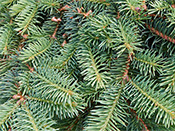
Balsam Fir Essential Oil is also known as Canadian Balsam Fir Essential Oil or just Canadian Fir Essential Oil. It is a highly aromatic tree that is indigenous to Canada and northern regions of the United States. In North America, the Balsam Fir is a species traditionally cut and sold as Christmas trees. Aromatically, Balsam Fir Essential Oil offers a fresh, vibrant, coniferous aroma.
View Full Profile for Balsam Fir Essential Oil
Fir, Douglas (Douglas-Fir)
Botanical Name: Pseudotsuga menziesii
Plant Part(s) Typically Distilled: Needles and Twigs
Conservation Status: Least Concern*
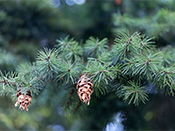
Douglas Fir is also known as Oregon Pine. The tree does not fall within the traditional fir Genus of Abies and is not considered to be a true fir tree. However, it is a member of the Pinaceae (Pine) family as is the Abies Genus. You may see the tree sometimes spelled with a hyphen as in Douglas-fir. Douglas Fir Essential Oil offers a somewhat sweeter and more complex aroma when compared to the aroma of other conifer needle oils. I find it to be woody and characteristically pine-like, but it also features layers of citrus and floral notes.
View Full Profile for Douglas Fir Essential Oil
Fir, Siberian
Botanical Name: Abies sibirica
Plant Part(s) Typically Distilled: Needles and Twigs
Conservation Status: Least Concern*
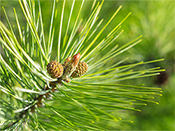
Siberian Fir Essential Oil is one of my favorite conifer needle essential oils because it is less abundant in monoterpenes than most of the conifer needle oils and therefore is less stimulating. It has a gently fresh yet mellow, woody aroma. Another bonus for this lovely oil is that it tends to be more affordably priced compared to many other essential oils distilled from conifer needles and twigs.
View Full Profile for Siberian Fir Essential Oil
Fir, Silver (White)
Botanical Name: Abies alba
Plant Part(s) Typically Distilled: Needles
Conservation Status: Least Concern*
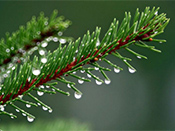
Silver Fir Essential Oil is a lovely fir oil with a beautiful, traditional "forest" aroma. It is available from many suppliers and is affordably price. It's one of my favorite conifer essential oils to use around the Christmas and winter holidays. However, it's a highly beneficial essential oil that shouldn't be merely limited to holiday themed aromatic applications.
View Full Profile for Silver Fir Essential Oil
Pine, Pinyon
Botanical Name: Pinus edulis
Plant Part(s) Typically Distilled: Needles and Twigs
Conservation Status: Least Concern*
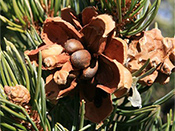
Aromatically, Pinyon Pine is one of my absolute favorite conifer essential oils. It has a potent, crisp pine aroma that can help to enhance the aroma of more dull or lifeless smelling conifer oils. Emotionally, I feel especially drawn to Pinyon Pine Oil and love including it intended to help support confidence and motivation. This is a conifer that I very much want to learn more about and work with on a deeper level.
View Full Profile for Pinyon Pine Essential Oil
Pine, Scotch (Scots)
Botanical Name: Pinus sylvestris
Plant Part(s) Typically Distilled: Needles
Conservation Status: Least Concern*
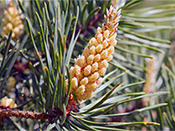
Scotch Pine Essential Oil is considered to be a cleansing and a clearing essential oil, and it can be helpful for clearing the mind of clutter and helping to clear a space of negativity prior to meditation. It is an energizing and uplifting oil that can help combat fatigue and support focus. Be sure to view the full profile for more information.
View Full Profile for Scotch Pine Essential Oil
Spruce, Black
Botanical Name: Picea mariana
Plant Part(s) Typically Distilled: Needles and Twigs
Conservation Status: Least Concern*
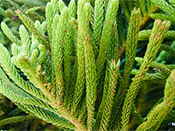
I resonate so well physically and emotionally with spruce oils, and Black Spruce is an absolute favorite. Unlike some conifers such as Hemlock Spruce, the IUCN Redlist designates Black Spruce as being of Least Concern, meaning that the species has been carefully evaluated and is not endangered or threatened. Emotionally, I find Black Spruce Essential Oil to be energizing and stimulating when I feel lethargic, but as with Hemlock Spruce Essential Oil, I don't find it to be over stimulating.
View Full Profile for Black Spruce Essential Oil
Spruce, Blue
Botanical Name: Picea pungens
Plant Part(s) Typically Distilled: Needles and Twigs
Conservation Status: Least Concern*
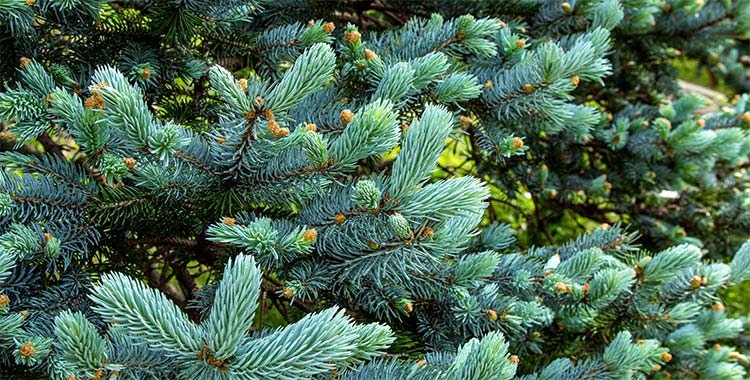
Blue Spruce Essential Oil possesses bold characteristics that are not present in many other commonly available conifer essential oils. When blended using a low ratio, Blue Spruce Essential Oil can liven up an otherwise dull or common blend without overpowering it. As with Black Spruce Essential Oil and Hemlock Spruce Essential Oil oils, I find that it's invigorating and uplifting without being overly stimulating. It's a lovely oil to incorporate into blends intended to help support focus and balance the emotions.
View Full Profile for Blue Spruce Essential Oil
Spruce, Hemlock
Botanical Name: Tsuga canadensis / Pinus canadensis
Plant Part(s) Typically Distilled: Needles and Twigs
Conservation Status: Near Threatened*
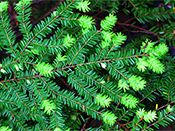
The genus for most spruce trees is Picea. However, for Hemlock Spruce, the genus is Tsuga. It has a beautiful, fresh spruce aroma that I find especially pleasant. However, this species is near threatened according to the IUCN Redlist. Although it's only the needles and twigs that are distilled, it's important to source the oil mindfully.
View Full Profile for Hemlock Spruce Essential Oil
The Cupressaceae Family
Essential Oils Distilled from Conifers in the Cupressaceae Family
Cedarwood, Virginian
Botanical Name: Juniperus virginiana
Plant Part(s) Typically Distilled: Wood
Conservation Status: Least Concern*
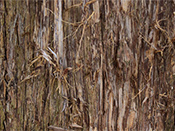
Virginian Cedarwood Essential Oil is one of the first three essential oils that I ever purchased so many years ago, and it still holds a special place in my heart. It possesses a rich, earthy and grounding aroma. The IUCN Redlist designates it as being of Least Concern, meaning that the species has been carefully evaluated and is not endangered or threatened. I love using Virginian Cedarwood whenever possible as a substitute for Atlas Cedarwood which is endangered. Learn more about this beneficial oil by reading the full profile.
View Full Profile for Virginian Cedarwood Essential Oil
Cypress
Botanical Name: Cupressus sempervirens
Plant Part(s) Typically Distilled: Needles
Conservation Status: Least Concern*
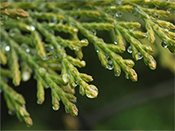
Cypress Essential Oil is a very stimulating and energizing essential oil that offers a fresh, sweet woody aroma. For me, cypress is one of the first essential oils that I reach for when I'm tired or need help being able to concentrate. I don't typically use it as a single essential oil, but instead prefer blending it with other essential oils that are synergistic to the goal I'm trying to achieve.
View Full Profile for Cypress Essential Oil
Cypress, Blue
Botanical Name: Callitris intratropica
Plant Part(s) Typically Distilled: Wood
Conservation Status: Unknown - Not Enough Data*
Blue Cypress is a beautiful Australian oil that is anti-inflammatory and emotionally grounding. To the best of my knowledge, Blue Cypress Oil is the only blue oil derived from the wood of a tree. The other blue oils like Yarrow, German Chamomile and Blue Tansy are distilled from the flowers and buds.
View Full Profile for Blue Cypress Essential Oil
Cypress, Taiwan (Formosan/Hong Kuai)
Botanical Name: Chamaecyparis formosensis
Plant Part(s) Typically Distilled: Twigs/Wood
Conservation Status: Endangered*
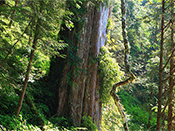
Aromatically, Taiwan Hinoki Essential Oil possesses a slightly sharp, woody aroma and is primarily used for emotional, energetic and spiritual applications. I don't personally love the aroma of the essential oil on its own, but I do like it when used in moderation in blends. However, the tree is endangered, so it's very important that you please be mindful of sustainability and conservation issues when purchasing the oil.
View Full Profile for Taiwan Cypress Essential Oil
Hinoki (Cypress, Japanese)
Botanical Name: Chamaecyparis obtusa
Plant Part(s) Typically Distilled: Needles, Twigs/Wood or Root
Conservation Status: Near Threatened*
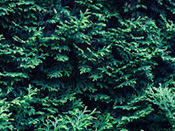
Hinoki Essential Oil goes by several common names. View the full profile to learn more about the names it tends to go by. The aroma and therapeutic properties of the oil vary depending on whether the oil is distilled from the needles, twigs or the root. When purchasing Hinoki Oil, be sure to verify the botanical name, plant parts used in the distillation and the sustainability/conservation efforts used in its production.
View Full Profile for Hinoki Essential Oil
Juniper Berry
Botanical Name: Juniperus communis
Plant Part(s) Typically Distilled: Berries
Conservation Status: Least Concern.* Exception: It is considered Critically Endangered in Morocco and Endangered in Albania and Belgium according to pages 5, 9 and 10 of the report Threatened, Endangered And Vulnerable Tree Species: A Comparison Between FRA 2005 And The IUCN Red List.
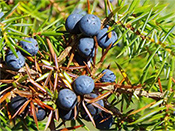
As its name would indicate, Juniper Berry Essential Oil is steam distilled from the berries of the Juniperus communis. However, it can be prudent to doublecheck when purchasing the oil to verify that it's indeed the berry oil. Sometimes, the leaves are included in the distillation, but the best oils are derived from the distillation of just the ripe berries.6 The oil possesses a crisp, woody, sweet and earthy. There's lots to say about this beautiful and therapeutic oil. Be sure to view the full profile for more details.
View Full Profile for Juniper Berry Essential Oil
*Conservation Status
It's so important that we are each mindful of the conservation status of the trees and plants that are used in the distillation of the oils that we purchase and work with. The conservation status information that appears in this guide and that you see included on most of AromaWeb's essential oil profiles comes from the IUCN Red List of Threatened Species. IUCN stands for the International Union for Conservation of Nature. To learn more about the conservation status of essential oil bearing plants and how to use the IUCN Red List of Threatened Species, please refer to AromaWeb's Guide to Essential Oils and Sustainability.
References
1 Conifer: Definition in the Merriam-Webster Dictionary. Accessed: December 12, 2019.
2 Evergreen: Definition in Wikipedia. Accessed: December 13, 2019.
3 Pinales Classification in the USDA Plant Database. Accessed: December 12, 2019.
4 Robert Tisserand and Rodney Young, Essential Oil Safety (Second Edition. United Kingdom: Churchill Livingstone Elsevier, 2014), 266.
5 Sharon Falsetto, What is Forest Bathing?. Sedona Aromatics Blog. Accessed: December 13, 2019.
6 Salvatore Battaglia, The Complete Guide to Aromatherapy Third Edition Volume 1 - Foundations & Materia Medica (Brisbane Australia: Black Pepper Creative, 2018), 350.
General Safety Information
Do not take any oils internally and do not apply undiluted essential oils, absolutes, CO2s or other concentrated essences onto the skin without advanced essential oil knowledge or consultation from a qualified aromatherapy practitioner. For general dilution information, read AromaWeb's Guide to Diluting Essential Oils. If you are pregnant, epileptic, have liver damage, have cancer, or have any other medical problem, use oils only under the proper guidance of a qualified aromatherapy practitioner. Use extreme caution when using oils with children and be sure to first read the recommended dilution ratios for children. Consult a qualified aromatherapy practitioner before using oils with children, the elderly, if you have medical issues or are taking medications. Before using this or any essential oil, carefully read AromaWeb's Essential Oil Safety Information page. For in-depth information on oil safety issues, read Essential Oil Safety by Robert Tisserand and Rodney Young.
Shelf Life
Important Information About the Profiles
The essential oil information provided on AromaWeb is intended for basic educational purposes only. The references to safety information, test results, constituents and percentages is generalized information. Essential oils can vary greatly in composition. The data is not necessary complete and is not guaranteed to be accurate. The essential oil photos are intended to represent the typical and approximate color of each essential oil. However, essential oil composition and color can vary based on harvesting, distillation, age of the essential oil and other factors. Profiles for several CO2 Extracts and absolutes are included within the directory, and are denoted as such.
